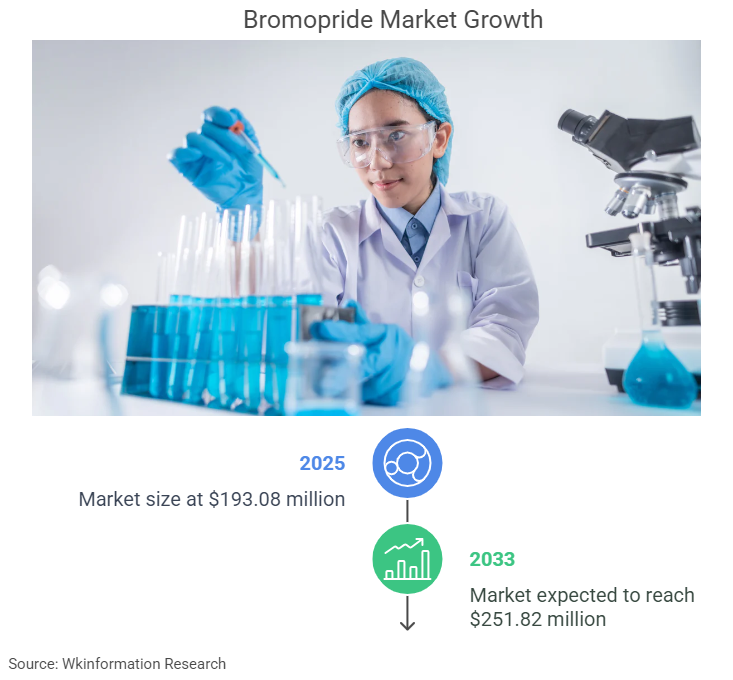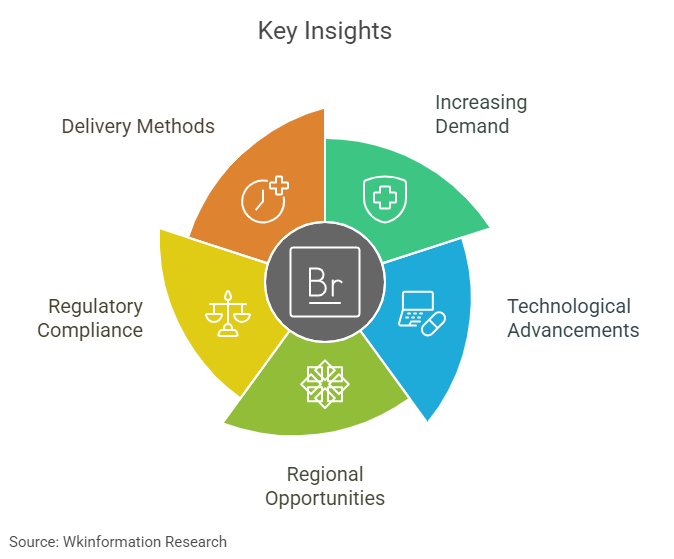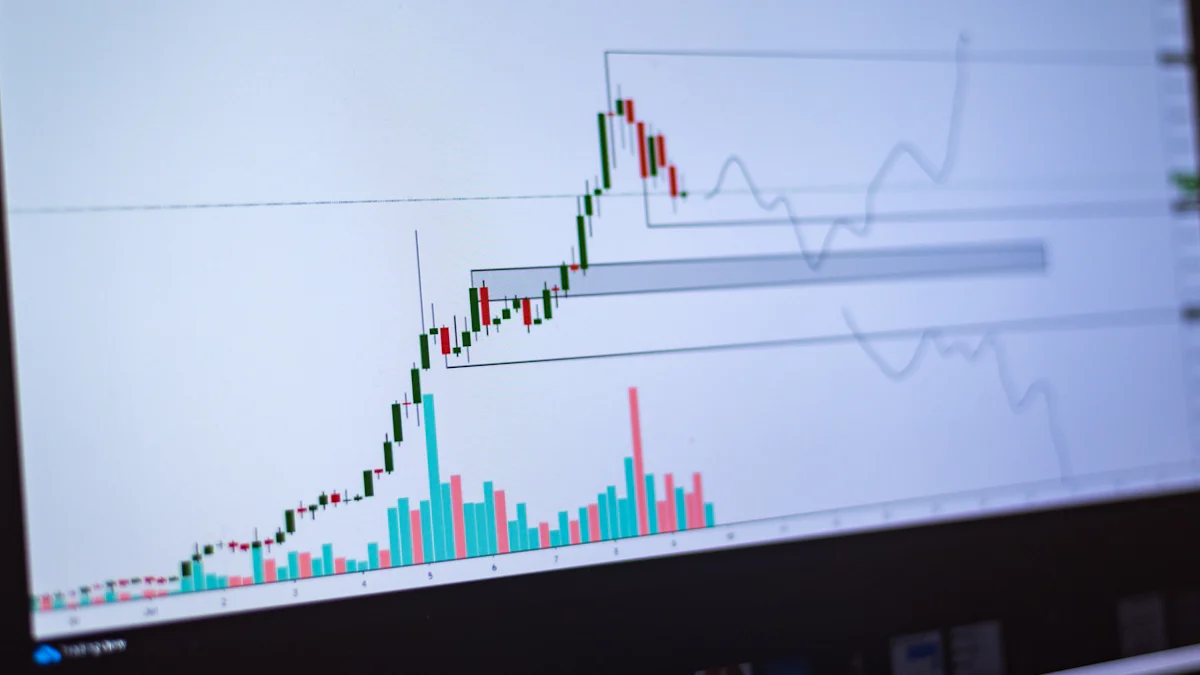
The Bromopride market plays a pivotal role in the global pharmaceutical industry, addressing the growing demand for effective gastrointestinal treatments. Over the past five years, the market has shown remarkable growth, with its size at $193.08 million in 2025. Projections indicate a compound annual growth rate (CAGR) of 3.38%, with the market expected to reach $251.82 million by 2033. This growth is driven by rising healthcare expenditures, advancements in pharmaceutical manufacturing, and a focus on research and development. Emerging biopharma trends, such as novel drug delivery systems and improved formulations, are further shaping the market’s future, particularly in regions like Asia-Pacific and Latin America. These innovations enhance the efficacy and safety of Bromopride products, meeting diverse patient needs and expanding market opportunities.
Key Insights
- The Bromopride market is growing fast and may reach $251.82 million by 2033. This is because more people need stomach-related treatments.
- New technology, like AI and machines, makes drug-making faster. It also helps create medicines suited for each person.
- Countries in Asia-Pacific and Latin America have big chances to grow. This is due to better healthcare and more people learning about it.
- Following rules is very important for companies. Those who follow them can make better products and stay ahead.
- Using new ways to give medicine, like slow-release pills, helps patients take their medicine and feel better.

Market Overview
Current State of the Bromopride Market
The Bromopride market has experienced significant growth in recent years, driven by increasing demand for effective gastrointestinal treatments. In 2025, the market was valued at approximately USD 193.08 million. Analysts project a robust Compound Annual Growth Rate (CAGR) of 3.38% from 2025 to 2033. This growth reflects rising adoption of Bromopride in the pharmaceutical industry and heightened awareness of gastrointestinal conditions worldwide. Production levels have also surged to meet the growing demand, with manufacturers focusing on improving efficiency and scalability. Revenue generation continues to rise, supported by expanding applications and advancements in drug formulations.
Key Market Drivers
Several factors contribute to the expansion of the Bromopride market. The prevalence of gastrointestinal disorders has increased globally, prompting higher demand for effective treatments. Healthcare providers and pharmaceutical companies are prioritizing Bromopride due to its proven efficacy and safety profile. Rising healthcare expenditures and government initiatives to improve access to essential medicines further bolster market growth. Additionally, advancements in pharmaceutical manufacturing technologies enable the production of high-purity Bromopride, enhancing its therapeutic potential. Emerging markets, particularly in Asia-Pacific, present lucrative opportunities due to growing healthcare infrastructure and increasing patient awareness.
Product Segmentation
By Type
The global market is segmented based on purity levels, with the key categories being 98% Pure, 99% Pure, and Other. The 98% Pure segment likely accounts for a significant portion of the market, as it balances cost and performance, making it suitable for a wide range of industrial and commercial applications. This segment is commonly used in industries where ultra-high purity is not a strict requirement, such as certain manufacturing and construction sectors.
The 99% Pure category caters to industries where higher purity is critical, such as pharmaceuticals, electronics, and aerospace. These sectors demand materials with minimal impurities to ensure the safety, reliability, and performance of their products. As a result, the 99% Pure segment is expected to show steady growth, driven by increasing technological advancements and the rising demand for high-quality materials.
The “Other” category includes various purities that do not conform to the 98% or 99% benchmarks. This could cover a wide range of specialized products used in niche markets, where specific purity levels are needed for particular applications. These materials may also be used in research and development or customized solutions where flexibility in purity is required.
By Application
The global market for Bromopride is divided into four key applications: Drug, Cosmetic, Agriculture, and Other.
In the Drug sector, Bromopride is primarily used as an antiemetic, helping to manage nausea and vomiting in patients undergoing chemotherapy or surgery. The pharmaceutical applications of Bromopride are growing as the demand for effective treatments in healthcare increases globally.
In Cosmetics, Bromopride’s skin-conditioning and anti-inflammatory properties make it a popular ingredient in products aimed at improving skin texture and reducing irritation. As consumers seek more multifunctional skincare solutions, this segment is expanding steadily.
The Agriculture sector uses Bromopride for pest control and plant protection, helping to improve crop yields and resistance. This segment benefits from the growing demand for sustainable agricultural practices and more effective pest management solutions.
The Other category includes various niche applications, such as research or industrial uses, where Bromopride’s unique properties are beneficial in specialized fields.
Regional Analysis
North America
North America dominates the Bromopride market, holding the largest share globally. Advanced healthcare infrastructure and high consumer purchasing power contribute significantly to this leadership. The region benefits from favorable reimbursement policies, which enhance patient access to Bromopride-based treatments. High awareness among healthcare professionals and patients regarding gastrointestinal disorders further drives demand. The robust regulatory frameworks in the United States and Canada ensure the availability of high-quality pharmaceutical products. These factors collectively position North America as a key player in the global Bromopride market.
Europe
Europe represents another major market for Bromopride, driven by its sophisticated healthcare systems. Countries like Germany, France, and the United Kingdom lead the region due to their strong pharmaceutical industries and high healthcare spending. The increasing geriatric population in Europe plays a crucial role in market growth, as older adults are more prone to gastrointestinal disorders. Additionally, the rising prevalence of chronic diseases associated with gastrointestinal complications has heightened the demand for effective treatments. These dynamics make Europe a vital region for Bromopride market expansion.
Asia-Pacific
The Asia-Pacific region is projected to experience the highest growth rate in the Bromopride market. Rapid urbanization and industrialization have led to a growing middle class with increased healthcare awareness. Countries such as China, India, and Japan stand out due to their large patient populations and improving healthcare infrastructure. The rising prevalence of gastrointestinal disorders in these nations has created a significant demand for Bromopride-based therapies. Government initiatives to enhance healthcare access and affordability further support market growth in this vibrant region.
Rest of the World
Emerging economies in Latin America, Africa, and the Middle East present untapped potential for the Bromopride market. Increasing investments in healthcare infrastructure and government support are driving growth in these regions. The rising prevalence of gastrointestinal conditions, coupled with growing patient awareness, has created opportunities for market expansion. Although these regions currently hold a smaller market share, their development offers promising prospects for the future of the Bromopride market.
Emerging Trends in the Bromopride Market

Technological Advancements in Drug Development
The Bromopride market is witnessing significant technological advancements that are transforming drug development processes. Companies are integrating automation and artificial intelligence (AI) into production workflows to enhance efficiency and reduce operational costs. These technologies streamline manufacturing, ensuring consistent quality and scalability. The development of personalized pharmaceutical solutions is another notable trend. Customized Bromopride formulations tailored to individual patient needs are gaining traction, offering improved therapeutic outcomes.
Sustainable manufacturing practices are also reshaping the industry. Eco-friendly production methods are being adopted to meet regulatory standards and align with consumer preferences for environmentally responsible products. Additionally, formulation innovations, such as sustained-release tablets and improved oral solutions, are enhancing drug absorption and patient compliance. Collaborative partnerships between pharmaceutical companies and research institutions are further driving accessibility and quality compliance in Bromopride products.
Regulatory Changes and Their Implications
Recent regulatory changes are influencing the Bromopride market significantly. Manufacturers must comply with stringent international and regional regulations, which often involve complex and time-intensive processes. These regulations aim to ensure the safety, efficacy, and quality of pharmaceutical products. While compliance can pose challenges, it also drives innovation by encouraging companies to adopt advanced technologies and sustainable practices.
Regulatory compliance has become a critical factor for market players. Companies that successfully navigate these requirements gain a competitive edge by delivering high-quality products that meet global standards. This dynamic underscores the importance of aligning business strategies with evolving regulatory frameworks.
Shifts in Consumer Demand and Preferences
Consumer demand for Bromopride products is shifting due to increased awareness of gastrointestinal health and the availability of novel drugs. Patients now prioritize treatments that offer convenience, safety, and efficacy. This trend has led to a growing preference for innovative formulations, such as sustained-release tablets, which improve adherence to treatment regimens.
The focus on personalized medicine is also influencing consumer preferences. Patients and healthcare providers are seeking tailored solutions that address specific needs, driving demand for customized Bromopride formulations. Additionally, the emphasis on eco-friendly products reflects broader societal trends toward sustainability. Companies that align their offerings with these preferences are better positioned to capture market share and foster long-term growth.
Integration of Biopharma Trends and Digital Transformation
The Bromopride market is undergoing a significant transformation driven by the integration of biopharma trends and digital technologies. This shift is reshaping how manufacturers develop, market, and distribute pharmaceutical products. Digital transformation has introduced innovative tools and platforms that enhance operational efficiency and improve patient outcomes.
Telemedicine and digital platforms have emerged as pivotal components in this evolution. These technologies increase the visibility and accessibility of Bromopride-based treatments. Patients can now access information and consultations through virtual channels, reducing barriers to care. Manufacturers leverage these platforms to promote their products effectively, expanding their market reach and fostering stronger patient engagement. This approach not only improves treatment adherence but also builds trust between healthcare providers and patients.
Biopharma trends, such as the adoption of artificial intelligence (AI) and machine learning (ML), are further revolutionizing the industry. AI-driven analytics enable manufacturers to predict market demands and optimize production processes. ML algorithms assist in identifying patient-specific treatment needs, paving the way for personalized Bromopride formulations. These advancements ensure that patients receive tailored therapies, enhancing therapeutic efficacy and satisfaction.
Blockchain technology is also gaining traction in the pharmaceutical sector. It provides a secure and transparent system for tracking Bromopride products throughout the supply chain. This innovation minimizes the risk of counterfeit drugs and ensures compliance with regulatory standards. By integrating blockchain, companies can maintain product integrity and build consumer confidence.
The convergence of biopharma trends and digital transformation is creating a dynamic and patient-centric Bromopride market. Companies that embrace these advancements position themselves as leaders in innovation and quality. This integration not only addresses current challenges but also sets the stage for sustainable growth and improved healthcare delivery.
Investment and Financial Insights
Venture Capital and Funding Patterns
The Bromopride market has attracted significant attention from venture capitalists due to its promising growth trajectory. Investors are increasingly drawn to companies that focus on innovative drug formulations and advanced manufacturing technologies. Startups specializing in Bromopride development have emerged as key beneficiaries of this trend. These firms often secure funding to enhance research capabilities and accelerate product development.
A notable financial trend in the market is the emphasis on innovation-driven investments. Companies that prioritize research and development (R&D) receive substantial backing, enabling them to create high-quality products. The rising demand for gastrointestinal treatments further fuels this investment activity. As healthcare expenditures continue to grow globally, venture capitalists remain optimistic about the market’s potential.
IPOs and Public Offerings in the Life Sciences Sector
Initial Public Offerings (IPOs) have become a pivotal strategy for companies in the life sciences sector, including those involved in Bromopride production. Public offerings provide firms with the capital needed to expand operations, invest in R&D, and strengthen their market presence. Over the past decade, several pharmaceutical companies have leveraged IPOs to fund large-scale projects and enter new markets.
The Bromopride market benefits from this trend as public offerings increase investor confidence and attract additional funding. Companies that successfully launch IPOs often experience enhanced visibility, which helps them establish credibility in the competitive pharmaceutical landscape. This financial strategy not only supports growth but also fosters innovation by enabling firms to allocate resources toward advanced drug development.
Mergers, Acquisitions, and Strategic Collaborations
Mergers and acquisitions (M&A) play a crucial role in shaping the Bromopride market. These strategic moves allow companies to expand their product portfolios, improve distribution networks, and gain a competitive edge. Collaborative partnerships also enable firms to share resources and expertise, accelerating the development of high-quality pharmaceutical products.
Such collaborations highlight the importance of strategic alliances in driving market growth. By pooling resources, companies can overcome challenges related to regulatory compliance and production scalability. These partnerships also facilitate the introduction of innovative Bromopride formulations, meeting the evolving needs of patients and healthcare providers.
Competitive Landscape and Key Players
The Bromopride market features a dynamic competitive landscape shaped by the efforts of leading pharmaceutical companies. These key players employ diverse strategies to maintain their market positions and address evolving consumer demands. Their focus on innovation, research, and strategic partnerships drives the market’s growth and ensures the availability of high-quality products.
Companies like Lebsa and Cayman Chemical lead the market by prioritizing innovation and blending advanced technologies with traditional expertise. Their robust research and development efforts result in cutting-edge formulations that meet stringent regulatory standards. MedChemExpress and ICROM emphasize sustainability and compliance, ensuring their products align with global quality benchmarks.
Strategic investments in research and development play a pivotal role in maintaining competitiveness. Firms such as Manus Aktteva Biopharma LLP and ALFA Chemistry allocate significant resources to clinical trials and product innovation. These efforts not only enhance product efficacy but also build consumer trust. Additionally, companies like TLC leverage extensive distribution networks to expand their market reach, while SimSon Pharma focuses on developing formulations for new therapeutic indications.
The competitive landscape reflects a strong commitment to addressing consumer needs and adapting to market trends. By combining innovation, strategic partnerships, and targeted investments, these key players continue to shape the future of the Bromopride market.
Challenges and Opportunities

Regulatory and Compliance Barriers
The Bromopride market faces significant challenges due to stringent regulatory requirements. Manufacturers must navigate complex international and regional regulations to ensure product safety and efficacy. These processes often demand substantial time and resources, creating barriers for smaller companies. Regulatory frameworks also vary across regions, complicating compliance for global manufacturers. Companies that fail to meet these standards risk delays in product approvals and potential financial penalties. However, firms that align their operations with these regulations can gain a competitive edge by delivering high-quality products that meet global benchmarks.
Supply Chain and Distribution Challenges
The supply chain for Bromopride production encounters several obstacles that impact efficiency and cost. Key challenges include:
- Regulatory Compliance Issues: Adhering to diverse regulations across regions adds complexity to the distribution process.
- High Competition: The increasing number of pharmaceutical companies intensifies competition, requiring greater investment in branding and marketing.
- Raw Material Sourcing Challenges: Obtaining high-quality raw materials for Bromopride production remains a logistical hurdle in certain areas, leading to delays and increased costs.
Addressing these challenges requires strategic planning and investment in robust supply chain management systems. Companies that optimize their logistics and sourcing processes can reduce costs and improve product availability.
Growth Opportunities in Emerging Markets
Emerging markets present substantial opportunities for the Bromopride industry. The Asia-Pacific region, in particular, is expected to experience the highest growth rate due to its large patient populations and increasing healthcare awareness. Countries like China, India, and Brazil are witnessing rising demand for gastrointestinal treatments, driven by improving healthcare infrastructure and growing disposable incomes.
Key factors contributing to this opportunity include:
- Expanding healthcare investments in Asia, Latin America, and the Middle East.
- Rising awareness of gastrointestinal disorders and the need for effective treatments.
- Strategic partnerships and local manufacturing initiatives to enhance market presence.
By focusing on these regions, companies can tap into untapped potential and drive long-term market growth.
Potential for Innovation in Drug Delivery Methods
Innovative drug delivery methods are transforming the Bromopride market by enhancing its efficacy, safety, and patient adherence. Controlled-release systems, transdermal patches, and orally disintegrating tablets represent some of the most promising advancements. These technologies aim to improve the drug’s therapeutic performance while addressing the diverse needs of patients. For instance, controlled-release systems allow for a gradual release of Bromopride, ensuring consistent therapeutic levels over extended periods. This approach minimizes side effects and reduces the frequency of dosing, which significantly improves patient compliance.
Transdermal patches offer another groundbreaking solution. By delivering Bromopride through the skin, these patches bypass the gastrointestinal tract, reducing the risk of irritation and enhancing bioavailability. Orally disintegrating tablets, on the other hand, dissolve quickly in the mouth without the need for water, making them ideal for patients with swallowing difficulties. These advancements align with the growing demand for personalized medicine, as they enable the development of formulations tailored to individual genetic profiles and treatment needs.
Several areas within the Bromopride market present opportunities for innovation:
- Investing in research and development for advanced formulations can enhance drug efficacy and patient outcomes.
- Sustained-release formulations and improved oral solutions offer better absorption rates and longer-lasting effects.
- Novel delivery systems, such as transdermal patches and orally disintegrating tablets, improve convenience and adherence.
- The focus on targeted therapies and personalized medicine drives the creation of patient-specific treatments.
These innovations not only address existing challenges but also position the Bromopride market for significant growth. By prioritizing advanced drug delivery methods, manufacturers can meet evolving consumer demands and establish a competitive edge in the pharmaceutical industry. The integration of these technologies underscores the market’s commitment to improving healthcare outcomes and expanding its global reach.
Future Outlook for the Bromopride Market
Predicted Market Growth and Trends
The bromopride market is poised for substantial growth over the next decade. Analysts project the market to grow at a compound annual growth rate (CAGR) of 3.38% from 2025 to 2033, driven by advancements in clinical research and the therapeutic effectiveness of novel drugs. By 2025, the market is expected to witness a surge in demand, fueled by the increasing prevalence of gastrointestinal disorders and the development of innovative pharmaceutical formulations. The market size, valued at $193.08 million in 2025, is anticipated to reach $251.82 million by 2033, reflecting the growing adoption of bromopride-based therapies worldwide.
Emerging biopharma trends, such as personalized medicine and targeted therapies, are reshaping the market landscape. These trends emphasize the importance of tailoring treatments to individual patient needs, enhancing therapeutic outcomes. Additionally, the integration of advanced drug delivery systems, including controlled-release formulations, is expected to improve patient compliance and treatment efficacy. By 2025, the focus on sustainability and eco-friendly manufacturing practices will further influence market dynamics, aligning with global regulatory standards and consumer preferences.
Long-Term Implications for Industry Stakeholders
The evolving bromopride market presents both opportunities and challenges for industry stakeholders. Key implications include:
- Mergers and acquisitions among pharmaceutical companies are expanding product portfolios and market access.
- Strategic collaborations are leveraging synergies in research, manufacturing, and distribution, enhancing competitive advantage.
- The rising demand for novel drugs and effective gastrointestinal treatments is driving market expansion.
- Emerging markets in Asia-Pacific and Latin America offer lucrative prospects for growth, supported by improving healthcare infrastructure.
- Technological advancements in biopharma are fostering innovation, enabling the development of high-quality, patient-centric therapies.
By aligning with these trends, stakeholders can capitalize on the market’s potential while addressing regulatory and operational challenges.
Strategic Recommendations for Market Players
To thrive in the bromopride market, companies should adopt strategic approaches that align with emerging opportunities. Recommendations include:
- Investing in research and development to create novel drugs and advanced formulations that enhance therapeutic efficacy.
- Expanding indications for bromopride beyond nausea and vomiting to address a broader range of gastrointestinal conditions.
- Leveraging biopharma trends, such as personalized medicine, to develop targeted therapies tailored to individual patient needs.
- Exploring partnerships and mergers, as demonstrated by Strides Pharma’s acquisition of Fairmed Healthcare, to strengthen market presence and diversify product offerings.
- Focusing on emerging markets, particularly in Asia-Pacific and Latin America, through local collaborations and targeted marketing strategies.
- Prioritizing innovation in drug delivery systems, such as controlled-release formulations and transdermal patches, to improve patient adherence and satisfaction.
By implementing these strategies, market players can position themselves as leaders in the bromopride market, driving sustainable growth and innovation by 2025 and beyond.
Overview
The Bromopride market continues to demonstrate robust growth. This expansion is driven by the rising prevalence of gastrointestinal disorders and the demand for effective treatments. Key trends, such as sustained-release formulations and strategic collaborations, are reshaping the industry landscape. Companies are leveraging innovation through advanced drug delivery systems and sustainable manufacturing practices to meet evolving consumer needs.
Mergers and acquisitions, like Strides Pharma’s acquisition of Fairmed Healthcare AG, highlight the market’s focus on expanding product portfolios and accessing new regions. By investing in research and forming strategic partnerships, stakeholders can unlock sustainable growth opportunities. Adapting to emerging biopharma trends ensures that the Bromopride market remains dynamic and patient-centric, paving the way for long-term success.
| Report Metric | Details |
|---|---|
| Report Name | Global Bromopride Market Report |
| Base Year | 2024 |
| Segment by Type | · 98% Pure
· 99% Pure · Other |
| Segment by Application | · Cosmetic
· Drug · Agriculture · Other |
| Geographies Covered | · North America (United States, Canada)
· Europe (Germany, France, UK, Italy, Russia) · Asia-Pacific (China, Japan, South Korea, Taiwan) · Southeast Asia (India) · Latin America (Mexico, Brazil) |
| Forecast units | USD million in value |
| Report coverage | Revenue and volume forecast, company share, competitive landscape, growth factors and trends |
FAQ
What is Bromopride, and what are its primary uses?
Bromopride is a pharmaceutical compound primarily used to treat gastrointestinal disorders, such as nausea, vomiting, and delayed gastric emptying. Its efficacy and safety profile make it a preferred choice for managing these conditions in clinical settings.
Which regions are driving the growth of the Bromopride market?
Asia-Pacific and Latin America are key growth regions. These areas benefit from expanding healthcare infrastructure, rising awareness of gastrointestinal disorders, and increasing demand for effective treatments.
How do technological advancements impact Bromopride production?
Technological advancements, such as automation and AI, enhance production efficiency and quality. These innovations streamline manufacturing processes, reduce costs, and enable the development of personalized formulations tailored to patient needs.
What challenges do manufacturers face in the Bromopride market?
Manufacturers encounter regulatory compliance barriers, supply chain inefficiencies, and raw material sourcing issues. These challenges require strategic planning and investment in robust logistics and quality assurance systems.
What are the future opportunities for innovation in Bromopride drug delivery?
Innovative delivery methods, such as controlled-release systems, transdermal patches, and orally disintegrating tablets, offer improved therapeutic outcomes. These advancements enhance patient adherence, reduce side effects, and align with the growing demand for personalized medicine.
Global Bromopride Market Report – Table of Contents
1 Market Study Overview
2 Basic Product Information
3 Market Analysis
4 Bromopride Related Market Analysis
5 Global Trend Summary
6 Competition by Manufacturer
7 Analysis of Key Players
8 Global Bromopride Revenue, Sales Categorized by Regions
9 North America Bromopride Market Size Categorized by Countries
10 Europe Bromopride Market Size Categorized by Countries
11 Asia-pacific Bromopride Market Size Categorized by Countries
12 South America Bromopride Market Size Categorized by Countries
13 Middle East and Africa Bromopride Market Size Categorized by Countries
14 Global Bromopride Industry Segment Analysis
15 Global Bromopride Market Forecast
16 Research Findings and Conclusion
17 Appendix


